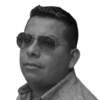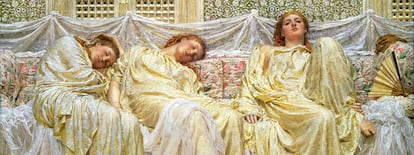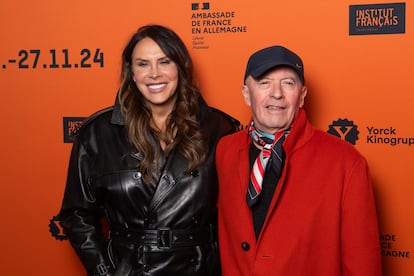 |
Leopold Musem, Viena |
PORTRAIT OF NELLY NEPPACH, 1925
Artists
- Emil Orlik
(Prague 1870–1932 Berlin)
 |
Leopold Musem, Viena |
(Prague 1870–1932 Berlin)
BL, 2021
WIKIPEDIA

Y_our story in this week’s issue, “The Size of Things,” involves an adult who seems to regress to childhood. Should we read it as a supernatural story or a metaphorical one?_
There is a gesture at the end toward the fantastic, it’s true, but it’s only a wink, and the story could all be read as merely a feeling of the narrator’s. It could be the story of an adult man trying to escape his mother’s control, who, in his desperation, becomes infantilized and takes refuge with another family. Really, if there is anything beyond that, it’s an idea that I’d like to trigger in the reader’s mind, but that isn’t formally written on the page.
We have the sense that Enrique’s mother has resisted his growing up—that she tries to keep him a child by asserting her power over him, physically and verbally. Is that what’s going on?
Yes. Even though we only actually meet that possessive and authoritarian mother in the final lines, it’s something that we can gradually deduce from Enrique himself, from the beginning of the story.
Do you think the couple who run the toy store are complicit in what happens to Enrique—or just innocent observers?
Their intentions are good, but they end up being passive accomplices to Enrique Duvel’s regression. Maybe it’s because for them it’s easier to deal with a child than with an adult, or maybe—because they seem to be a childless couple—they have a need to care for someone else, to feel needed themselves. In any case, it’s a strange relationship that clearly fills a need for all three of them.
Were you thinking of F. Scott Fitzgerald’s “The Curious Case of Benjamin Button” when you wrote this?
I wasn’t thinking of it, but, it’s true, the two pieces have points in common. It did occur to me, rereading the story for this publication, that the last line is very much like the ending of Roald Dahl’s story “The Man from the South”: both narrators have a revelation while looking at another character’s hand. And it’s strange because “The Size of Things” is an old story—I must have been twenty-two or twenty-three when I wrote it, and I read Roald Dahl many years later. I love it when those things happen. I like to think that at some point Roald and I passed through the same place—some corner of the collective unconscious—that caught our attention in a similar way.
In Argentina, the story appeared as part of a collection of stories, in which many things are not exactly what they seem or undergo transformations. Is the idea of metamorphosis important to your work?
Yes, it was for that book in particular. Writing it, I was at a stage when I felt as though ideas, to be strong, needed the power of more classic forms. It was a learning stage—though I’m still learning, really. But I do feel that, although the things I’m interested in writing about haven’t changed in the slightest, the forms through which I approach them have, and doors have gradually opened.
Do you have any models when you’re writing short stories? Any favorite stories you keep going back to?
I have my list of favorite stories, of course, although it changes every year. But I am fairly intuitive in my writing, and I feel that the clues to how each story should be written lie within the idea for the story itself. Even so, I think that past readings, even the stories I have ostensibly forgotten, are always there working silently in my mind—even if, when I sit down to write, I’m not thinking of them directly.
Your novel “Fever Dream” was recently published in the U.S. How does the experience of being published here differ from your experience in Argentina?
Being translated into English, for a young Latin American author, is a kind of prize; in the eyes of Spanish-speaking critics and readers, it’s almost a consecration. And this, along with the novel’s nomination for the Man Booker International Prize, has given it an unexpected push, which likewise led to translations into other languages. If the book had remained in the Spanish-speaking world only, it would have been difficult for it to reach so many readers. So I feel very grateful for and happy about everything that has happened since the book’s English translation.
(Translated, from the Spanish, by Megan McDowell.)

12 JULY 2019
The Tale of Genji has played a substantial role in the formation of Japanese culture, and has lost none of its radiance in the millennium since it was written.
Reading The Tale of Genji is an excellent way to understand Japanese literature, and the country’s culture in general. Its devoted readers over the centuries include Kawabata Yasunari, the winner of the 1968 Nobel Prize for Literature, whose writings were suffused with the Japanese sense of aesthetics. His protégé Mishima Yukio, seen as a strong Nobel candidate, also took ideas from Genji.


The mutilation of ears and fingers is one of the most common practices of Los Pulpos (“The Octopuses”), a criminal organization dedicated to robbery, extortion and murder since the 1990s. It’s a family gang, led by four brothers, which emerged in the Cruz Verde shantytown in the province of Trujillo. Data from 2017 reveals that half of the population in the district of El Porvenir where the shantytown is located lives in poverty.

Everyone has heard that it’s vital to get seven to nine hours of sleep a night, a recommendation repeated so often it has become gospel. Get anything less, and you are more likely to suffer from poor health in the short and long term — memory problems, metabolic issues, depression, dementia, heart disease, a weakened immune system.

National security has been Donald Trump’s favorite argument to justify his long-awaited mass deportation of undocumented migrants. As a candidate, the Republican assured that his campaign of detentions and expulsions would target criminals, earning him the support of a majority of the population in the November election. In the first weeks of his presidency, however, the reality has proven different. In the raids carried out by the Immigration and Customs Enforcement Service (ICE), a high percentage of people without any criminal record are being arrested and deported.

Susanne Ussing (1940-1998) was a Danish visual artist and architect. One of her most striking works was this 1980 installation entitled I Drivhuset ( In the greenhouse ), installed at the Ordrupgaard Museum in Copenhagen. The sculpture depicts a female figure who has apparently become too big for (or has been trapped by) an imposing glass greenhouse. Constructed with newspaper clippings, wood and metal vents, the figure is so large that its feet seem to penetrate the brick floor below.


Reactions continue to emerge in response to Karla Sofía Gascón’s racist and xenophobictweets, which were leaked in late January, as well as to her handling of the controversy. The Emilia Pérez star has apologized but maintains that she is the target of a hate campaign to damage her reputation.
 |
| Han Kang |
From penetrating words to images that linger in the mind, Han Kang readers tell us what her work means to the
The 2024 Nobel prize in literature has been awarded to South Korean novelist Han Kang, 53, whose works include The Vegetarian, The White Book, Human Acts and Greek Lessons.
The Nobel committee praised Han’s “intense poetic prose that confronts historical traumas and exposes the fragility of human life”.
The Guardian asked readers of Han’s books to share what her writing means to them, with dozens getting in touch about their thoughts.
I read The Vegetarian first. I found it subversive, poetic, dark, violent, and genuine. It was something unlike anything I had read before and it seemed to stand in a league of its own.
It’s a deeply feminist book, purely because it’s a deeply human book that deals with a woman breaking with everything she has ever known – her family, her husband, all of society. It was a transformative read and an unpretentiously radical book.
Human Acts was traumatising in its immediacy – it was chilling and violent and I felt like I was there, with those students [during the 1980 student protests]. I emerge painfully transformed from all of Han Kang’s books.
Having raved about her to anyone who would listen, I was really thrilled to see her get this recognition. She is a unique voice that deserves to be heard everywhere in the world. Mia Kovačić, 34, communications director, Paris
I went to Skiathos, Greece this year and took Greek Lessons with me. I have recommended it to so many people since, saying that nothing happens but everything happens … it made me weep for the power of kindness.
Next was The Vegetarian, which I’ve had on my bookshelf for years. I read that one on the train to London and devoured it in a day. It says everything and everything happens.
Her writing is compelling and urgent and true. It’s a sucker punch and I’m so very glad I found her work. Katherine Wildman, 50, copywriter, near Newcastle
Han Kang’s works comfort the grief of Korean contemporary history and society. I’ve been soothed by them and influenced by their narratives, which have always left intense images in my mind and affected my writing and drawing. Like the endless darkness and solitude of I Do Not Bid Farewell, or the deprived hopes and misaligned yearnings of Human Acts.
I was in London studying the first time I read The Vegetarian. When I finished the book, I felt as if I’d watched a work of contemporary visual art – it embodied the powerful visualisation of its narrative. It captured me, tightly.
One great strength of her novels is to bring out the intangible lives of little people throughout Korean history and society, their historical and social griefs and agonies that are often disregarded. She captures the voices, and resistance, of vulnerable people – individuals who have fought for their existence. Noah Kim, 33, draws illustrations and writes short stories for children’s books, Seoul,South Korea
I am currently studying Korean and was loaned a copy of Human Acts by my professor. Once I started reading I couldn’t put it down, I read late into the night, straight to the final page.
I had been familiar with the events of 1980 [the Gwangju uprising and brutal repression], but the story, as it shifted from one narrator to the other, affected me deeply. The level of violence perpetrated against the students – the way a nation was terrorised – is something we see repeated often across the world. It is something I fear may unfold in the US.
But there can be a certain distance when we see media reports of events like this. What Han Kang’s writing has done is erase that distance – her words penetrate straight through the heart, and I am left feeling the loss of those children as if they were the classmates of my own son. Jenni Reid, works with children with special needs, Syracuse, New York
I was haunted by Han Kang’s Human Acts for months after reading it. I feel it creeping up sometimes, unannounced, and for no discernible reason. There are images in that book that will never leave me, like one scene at the beginning of Human Acts – a horror that immediately casts a shadow over the rest of the book.
For me, what’s special about Han Kang is that the severity of her themes and the raw brutality of the things she writes about are coupled with this intensity of language, this shameless, ceaseless, horrible beauty. She’s a writer who’s unafraid of bringing powerful emotions to the table, whose grasp of measure and proportion is admirable, all in service of evoking the unfathomable, that spontaneous violence that underlies our quotidian and that may be unearthed at any time.
I was jumping with joy for hours after the Swedish Academy’s announcement. There’s always been a dearth of attention to east Asian novels in the west, where a sort of tokenism is often accompanied by lack of any proper interest, particularly for women’s writing, a dearth that has only in recent years started to be redressed. Hugo Maio, 32, PhD researcher studying medieval Portuguese literature, Coimbra, Portugal